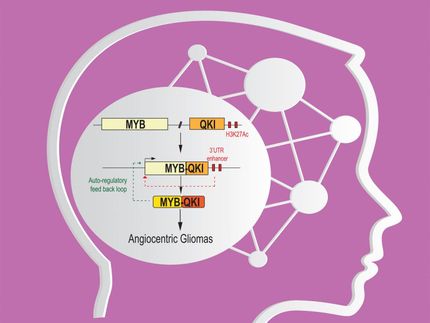Antidepressants plus blood-thinners slow down brain cancer
gliomas arise from the supportive cells of the brain, called "glial cells" when they begin to grow uncontrollably. The normal function of glial cells are to keep the brain's neurons in place and help them function properly. There are three types of glial cells, and glioma tumors often contain a mix of these.
Despite their aggressiveness and high mortality, there is currently little in the way of treatment for gliomas. Since the early 2000s, scientists have considered a category of antidepressants - called "tricyclic" - as a potentially new drug that could lower the risk of gliomas. However, a small clinical trial showed them to offer little benefit to glioma patients.
Making gliomas eat themselves
The laboratory of Douglas Hanahan in the Swiss Institute for Experimental Cancer Research (ISREC) at EPFL approached the problem by combining tricyclic antidepressants with anticoagulant drugs (blood-thinners). In a study designed and spearheaded by postdoctoral fellow Ksenya Shchors, the scientists screened anti-depressants in combination with several commercially available drugs suspected to have complementary effects in killing glioma cells. The screening revealed a class of anticoagulants as the most likely ally; these drugs interfered with the signaling activity of a receptor expressed on platelets and coincidentally upregulated in glioma cells.
The team investigated the effects of the two drugs in mice with gliomas. The animals received a "combination therapy", where they were given different doses of the drugs. The antidepressant was given orally, while the anticoagulant was injected 10-15 minutes later. Each combination therapy ran for five consecutive days.
The results showed that the drugs work together against the cancer cells. Specifically, the drugs disrupt a biochemical pathway in the glioma tumor cells that controls a mechanism known as "autophagy" - which literally means "to eat oneself". Low-level, controlled autophagy is a recycling mechanism that actually helps a cell to survive under stressful conditions. But, at excessively high levels, it can be lethal to cells.
The two drugs disrupt 'gate-keeper' mechanisms that normally operate at two different places along the regulatory pathway to limit the intensity of autophagic recycling, causing the cells to hyper-activate autophagy, virtually eating themselves alive. Although each drug can stimulate autophagy by itself, neither has any significant impact on the mortality of the mice with glioma. But when the EPFL scientists combined the two drugs, the lifespan of the mice doubled. Notably, these two classes of generic drugs had thus found a new purpose: they were not targeting neurons to limit depression or platelets to limit coagulation, respectively; rather, they were being repurposed based on their coincidental and synergistic ability to cause excessive autophagy in glioma cells.
"It is exciting to envision that combining two relatively inexpensive and non-toxic classes of generic drugs holds promise to make a difference in the treatment of patients with lethal brain cancer," says Douglas Hanahan. However, he warns that it is not clear yet if patients would benefit from such treatment. "This strategy is at an early stage and requires further more work to assess its full potential." Following up on this, the team is now making plans for early clinical trials.
Original publication
Other news from the department science

Get the life science industry in your inbox
By submitting this form you agree that LUMITOS AG will send you the newsletter(s) selected above by email. Your data will not be passed on to third parties. Your data will be stored and processed in accordance with our data protection regulations. LUMITOS may contact you by email for the purpose of advertising or market and opinion surveys. You can revoke your consent at any time without giving reasons to LUMITOS AG, Ernst-Augustin-Str. 2, 12489 Berlin, Germany or by e-mail at revoke@lumitos.com with effect for the future. In addition, each email contains a link to unsubscribe from the corresponding newsletter.




















































